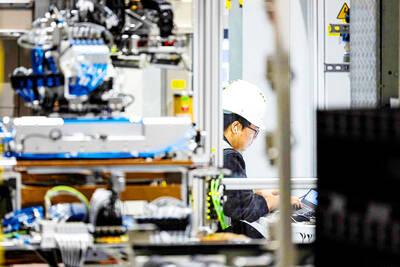Aggregate premium incomes collected by the nation’s life insurance companies in the first half of this year totaled NT$1.02 trillion (US$32.85 billion), down 7.7 percent from the same period last year, data released yesterday by the Life Insurance Association of the ROC showed.
That figure includes first-year premiums (FYPs), which fell 16.4 percent annually to NT$263.23 billion in the first six months, while renewal premiums — the subsequent premiums paid to keep the policy active — increased 4.2 percent to NT$753.97 billion over the same period, the association said in a report.
By product, traditional insurance policies generated premiums of NT$918.43 billion in the first half of this year, decreasing 7 percent year-on-year, with their FYPs falling 14.6 percent to NT$206.14 billion and renewal premiums dropping 4.5 percent to NT$712.29 billion over the period, the report said.

Photo courtesy of Nan Shan Life Insurance Co
Investment-linked insurance policies contributed premiums of NT$98.78 billion in the January-to-June period, falling 13.7 percent year-on-year, with FYPs down 22.5 percent to NT$57.1 billion.
However, renewal premiums rose 2.1 percent to NT$41.68 billion, it said.
The association blamed the decline in premiums of traditional insurance products on the effects of interest rate hikes by central banks, as local life insurers became conservative under the monetary tightening environment and moved slower to raise the declared interest rates for their products.
Although higher declared rates mean higher bonuses for policyholders, they leave insurers vulnerable to foreign-exchange risks, as most of their investments target overseas assets.
As a result, policyholders were either waiting or allocating their funds for other purposes, which was slowing sales of traditional insurance products, the association added.
As for the fall in premiums of investment-type insurance policies, the association pointed to the uncertainty in the global economy, which affects insurance policyholders’ attitude toward investment.

CHIP RACE: Three years of overbroad export controls drove foreign competitors to pursue their own AI chips, and ‘cost US taxpayers billions of dollars,’ Nvidia said China has figured out the US strategy for allowing it to buy Nvidia Corp’s H200s and is rejecting the artificial intelligence (AI) chip in favor of domestically developed semiconductors, White House AI adviser David Sacks said, citing news reports. US President Donald Trump on Monday said that he would allow shipments of Nvidia’s H200 chips to China, part of an administration effort backed by Sacks to challenge Chinese tech champions such as Huawei Technologies Co (華為) by bringing US competition to their home market. On Friday, Sacks signaled that he was uncertain about whether that approach would work. “They’re rejecting our chips,” Sacks

NATIONAL SECURITY: Intel’s testing of ACM tools despite US government control ‘highlights egregious gaps in US technology protection policies,’ a former official said Chipmaker Intel Corp has tested chipmaking tools this year from a toolmaker with deep roots in China and two overseas units that were targeted by US sanctions, according to two sources with direct knowledge of the matter. Intel, which fended off calls for its CEO’s resignation from US President Donald Trump in August over his alleged ties to China, got the tools from ACM Research Inc, a Fremont, California-based producer of chipmaking equipment. Two of ACM’s units, based in Shanghai and South Korea, were among a number of firms barred last year from receiving US technology over claims they have

It is challenging to build infrastructure in much of Europe. Constrained budgets and polarized politics tend to undermine long-term projects, forcing officials to react to emergencies rather than plan for the future. Not in Austria. Today, the country is to officially open its Koralmbahn tunnel, the 5.9 billion euro (US$6.9 billion) centerpiece of a groundbreaking new railway that will eventually run from Poland’s Baltic coast to the Adriatic Sea, transforming travel within Austria and positioning the Alpine nation at the forefront of logistics in Europe. “It is Austria’s biggest socio-economic experiment in over a century,” said Eric Kirschner, an economist at Graz-based Joanneum

France is developing domestic production of electric vehicle (EV) batteries with an eye on industrial independence, but Asian experts are proving key in launching operations. In the Verkor factory outside the northern city of Dunkirk, which was inaugurated on Thursday, foreign specialists, notably from South Korea and Malaysia, are training the local staff. Verkor is the third battery gigafactory to open in northern France in a region that has become known as “Battery Valley.” At the Automotive Energy Supply Corp (AESC) factory near the city of Douai, where production has been under way for several months, Chinese engineers and technicians supervise French recruits. “They